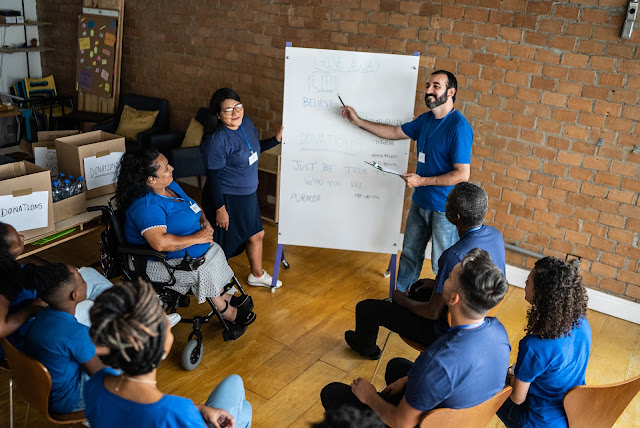By: James
H. Ford II, PhD, FACHE, LFHIMSS
Dr. Jay Ford is an associate professor in the School of Pharmacy at the University of Wisconsin-Madison. His teaching and research focus on the dissemination, implementation, and sustainment of organizational change in multiple healthcare environments, including acute care, behavioral health, and long-term care. He was also a member of the team that helped to develop and launch the NIATx model in 2003. We caught up with Jay recently to find out how he’s using NIATx in his work today.
What’s one “aha!” moment that you remember from the early days of NIATx?
It was probably one of the first times working with the Jackie Nitschke Center in Green Bay. I realized that the change team understood the importance of ensuring they set up a way to sustain the changes and improvements they'd made, even if the staff who were critical to the change left the organization. It was a sign that the model was getting legs and would be sustainable.
Do you have a favorite NIATx principle in the NIATx model?
Yes, and it's probably evolved a little bit. I would say my favorite one is NIATx principle 1, understand and involve your customers. But what’s also grown in favor is the principle of getting ideas from outside the organization–and that can mean organizations inside or outside the field.
Which NIATx principles or approaches were considered the most revolutionary for those first organizations that tried the NIATx model?
Again, NIATx principle 1: Understand and involve the customer. I remember a change leader in South Carolina telling us about the barriers she encountered when she called local agencies in the role of a client seeking treatment. It was eye-opening. Another example I often use when explaining the principle is the story of a phone ringing non-stop when someone called a treatment agency for an appointment. And lo and behold, when the change team investigated, they discovered that the line was still connected to an empty office with no phone.
How are you using the NIATx model today?
I'm using parts of it in my research focused on coaching. How do we assign that external facilitator to work with an organization? Sometimes the best coach isn't the engineer or scientist but the nurse, the counselor, or a trained NIATx coach. As we move outside addiction treatment and into new settings such as nursing homes, you may also need a clinical champion or clinical coach to move forward.
A current study I am working on is a continuation of the work I've been doing with Mark McGovern in Washington state that studied the use of the NIATx model to reduce waiting time for medications for people with co-occurring disorders.* We are now in year one of a five-year NIDA grant that is recruiting specialty addiction treatment clinics, FQHCs, and primary care clinics**. The study employs a measurement-based stepped implementation-to-target approach within an adaptive trial design to improve access to MOUD. In addition to a new internal facilitation implementation strategy, we’re using different components of the NIATx model, a variation of the NIATx Change Leader Academy, and an adaptation of external coaching with a virtual site visit.
Another example of NIATx in my research is my work with Bryan Garner on substance use treatment and HIV. In this project, we walk the HIV service organizations through three phases: preparation, implementation, and sustainment. The coach is still involved, but their focus depends on the organization's journey through the three phases.
I am also working with a UW-Madison infection disease specialist Chris Crnich on a project that targets improving antibiotic utilization in nursing homes. A coach connects with the nursing homes directly on and around antibiotic utilization, so we're primarily using the coaching component of NIATx in this study also.
Any other thoughts on how NIATx has evolved over the years in your research?
What I’ve found over the years is that the NIATx model is a simple, easy-to-use model that can be adapted and applied in many kinds of organizations. Coaching is the most effective implementation strategy to introduce the NIATx model. How coaching is delivered has also evolved in the last 20 years. We started with a more intensive coaching approach – quarterly in-person site visits and bi-weekly calls over an extended period (often 18 months). Although project or situation specific, coaching now often involves an initial site visit (in-person or virtual) and coaching calls tailored to organizational needs delivered over a shorter period. Despite how coaching has changed, I prefer the active role of working directly with healthcare organizations leads to a deeper understanding of how to best tailor the NIATx model and builds lasting connections that contribute to successful implementation and sustainment of organizational change.
Sources cited:
Ford, J. H., 2nd, Rao, D., Gilson, A., Kaur, A., Chokron Garneau, H., Saldana, L., & McGovern, M. P. (2022). Wait No Longer: Reducing Medication Wait-Times for Individuals with Co-Occurring Disorders. Journal of dual diagnosis, 18(2), 101–110.
Ford, J. H., 2nd, Cheng, H., Gassman, M., Fontaine, H., Garneau-Chokron, H., Keith, R., Michael, E., & McGovern, M. P. (2022). Stepped implementation-to-target: a study protocol of an adaptive trial to expand access to addiction medications. Implementation science: IS, 17(1), 64. https://doi.org/10.1186/s13012-022-01239-y PMCID: PMC9524103
About the author:
James H. Ford II, PhD, FACHE, LFHIMSS, Associate Professor, UW–Madison School of Pharmacy. Dr. Ford received his BS (1983) in Health Systems Engineering from the Georgia Institute of Technology in Atlanta, GA; his MS (1989) in Industrial Engineering from the University of Tennessee in Knoxville, TN, and his Ph.D. in Industrial Engineering (2004) from the University of Wisconsin, Madison WI. His dissertation examined how employee participation in and information about organizational change and their perceptions about change self-efficacy and coping skills influenced commitment to and behavior toward change. Read Dr. Ford’s full bio.



No comments:
Post a Comment